Composition analysis is a critical testing competency of food manufacturers and contract testing laboratories. Analyzing the composition of a product is vital to confirm compliance with regulations, accurate labeling, and consistent composition.
If you work in the food testing industry, you likely encounter various challenges, such as navigating the complexities arising from the increasing use of functional ingredients, coping with stricter regulations, safeguarding trademarks, maintaining brand image, and dealing with intense competitive pressures. To navigate these complexities effectively, you need to remain agile in response to reformulations and alternative products. Your goal is to deliver comprehensive and high-quality results in a timely manner to ensure no setbacks in product release. Leveraging the latest analytical technology is crucial to achieving this goal.
The resources below address five different aspects of food composition analysis – sugar, sugar substitutes and additives, vitamins, organic acids, and amino acids. These comprehensive analytical solutions from Waters are purposely designed to assist you in identifying a diverse range of chemical compounds, meeting compliance requirements, reducing operational costs, enhancing productivity, and, most importantly, safeguarding food quality.
Accurate identification and quantification of monosaccharides and disaccharides in food and beverage samples are critical for quality assurance and compliance verification. This accuracy is essential for:
Sugars are polar compounds and do not retain well on reversed-phase C18 columns. Consequently, the retention and separation of sugars are commonly performed using ion-exchange (IEX), ligand exchange or hydrophilic interaction liquid chromatography (HILIC). Additionally, unlike other classes of compounds discussed in this resource hub, sugars typically lack strong chromophores in their chemical structures. As a result, alternative detection methods to ultraviolet-visible light (UV-Vis), such as refractive index (RI), evaporative light scattering (ELS), or mass detection, become necessary. Each of these separation mechanisms and detection techniques has its own set of advantages and disadvantages, and the appropriate one should be selected based on your sample type, as well as the number and types of sugars you are analyzing.
Careful consideration also needs to be given to optimizing sample preparation and method development while ensuring compliance with stringent regulatory standards. By leveraging the latest methods and technologies, you can access analytical tools and optimized workflows to meet your specific needs.
Take a look at the resources below to discover:
Food additives comprise a wide range of substances, including colorings, antioxidants, preservatives, emulsifiers, stabilizers, gelling agents, thickeners, sweeteners, and flavor enhancers. Analyzing these additives is important to ensuring product specifications are met.
Sugar substitutes play a key role as flavor enhancers by providing desired sweetness while reducing overall energy content. These substitutes have gained significant interest, particularly with the implementation of sugar taxes. Standardizing the concentration and relative ratio of these diverse substitutes and sweeteners during the manufacturing processes is imperative to ensure consistent product flavor profiles.
Sugar substitutes consist of various compounds with distinct chemical structures and properties, presenting unique challenges for their analysis. For instance, certain sugar alcohols do not retain well on a C18 column and lack chromophores, necessitating the use of HILIC and detectors like RI, ELS, or mass spectrometer (MS). Others, such as aspartame, are prone to degradation, which can lead to the potential co-elution of degradant products with the target compounds, complicating the overall analysis.
To help navigate these challenges, Waters offers a range of HILIC columns, each designed to provide alternative selectivities for different types of sugar substitutes and sample matrices. Additionally, Waters has developed methods for beverage analysis based on the Beverage Analysis Kit. These established methods ensure reliable analyses, leveraging the robustness of Waters LC systems and user-friendliness of the chemistry products.
Explore the resources below to learn more about the latest technologies and techniques that can help optimize the analysis of sugar substitutes and additives. These comprehensive application notes demonstrate the analysis of sugar alcohols, sucralose, and other soft drink additives. These resources offer invaluable guidance to support you in maintaining product quality and ensuring compliance.
Meeting stringent regulatory requirements in the food industry requires clear labelling of nutritional content, including any added vitamins.
Liquid chromatography is commonly used for the routine analysis of vitamins, whether for a single analyte or for suites of vitamins. However, due to the relatively low separation efficiency and lengthy analysis times of traditional HPLC methods, many food testing laboratories have migrated their methods to more modern technologies designed for faster and higher resolution separations.
Waters pioneered ultra-performance liquid chromatography (UPLC) built around smaller particle-sized columns nearly 20 years ago. Since then, the technology has been widely adopted in analytical communities, including food testing organizations. The adoption of UPLC has yield significant advantages in reducing run times, decreasing solvent consumption, and improving quality and repeatability of separations. Beyond these benefits, UPLC proves invaluable in the identification of vitamins in complex matrices, especially when coupled with mass detection. This provides a more sensitive and selective detection technique compared to optical detection. It not only increases user confidence in compound identification but also allows for detection of vitamins at lower limits.
Take a closer look at the resources below to uncover how Waters solutions elevate food and beverage testing labs, enabling you to develop efficient vitamin testing methods for monitoring nutritional content and ensuring that product label claims are consistently met.
Download resource
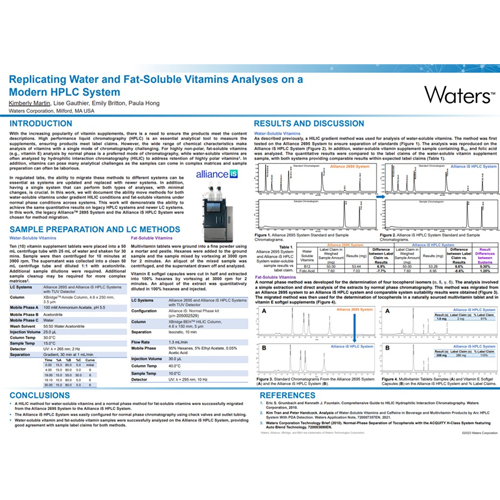
Download resource
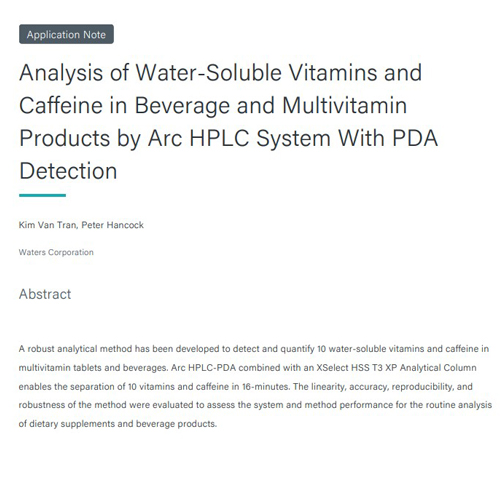
Download resource
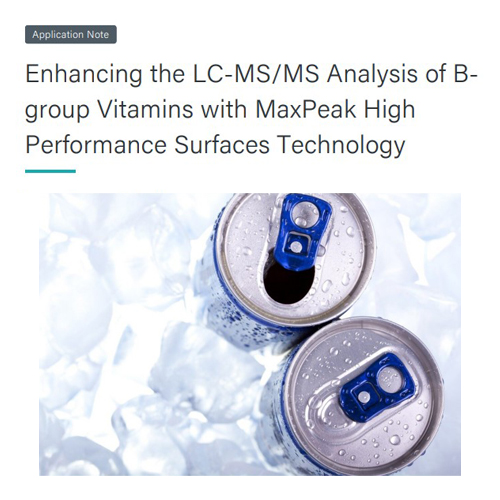
Organic acids, whether naturally present or added to food and beverage products, serve diverse roles such as preservation, antioxidation, acidity control, and flavor enhancement.
Analyzing organic acids presents unique challenges due to their polar properties. Firstly, they often prove challenging to retain on traditional C18 reversed-phase columns. Secondly, potential undesired interaction with metal surfaces within the analytical flow path, including the column, may compromise the sensitivity and peak shape of organic acids. Furthermore, the similarities in structures and characteristics among organic acids can complicate the separation of these compounds from each other and from matrix components, adding complexity to the analysis.
Traditionally, these challenges have been addressed by performing anion exchange chromatography to improve the resolution, or through time-consuming LC system and column passivation to minimize interaction between analytes and metal surfaces.
Waters has collaborated with food testing laboratories globally to better understand the difficulties users face, and has developed efficient solutions based on modern technologies to help you overcome these challenges quickly and easily:
Download the resources below to explore unique solutions designed to help you ensure product authenticity and check the consistency of quality and flavor profiles. These resources cover:
Amino acids are present in food and beverages as free amino acids or as the bound monomer units of proteins. The quality of a protein is often determined via its amino acid composition; therefore, accurate amino acid analysis is crucial. Free amino acids also serve as metabolic indicators that can be used to monitor and optimize processes such as fermentation.
There are two common chromatographic approaches for amino acid analysis: anion exchange separation with post-column derivatization and pre-column derivatization with reversed-phase separation. While anion exchange methods have been established for decades, they tend to have longer run times and lower sensitivity. In contrast, the pre-column derivatization approach utilizes a C18 reversed-phase column, often providing improved sensitivity, reproducibility, and shorter run times. A crucial consideration when performing pre-column derivatization is the stability of the derivatized amino acids. It is important that the derivatized amino acids remain stable for an acceptable duration, ensuring that the results are not affected by waiting in the sample queue or during repeated analyses.
Waters has accumulated years of experience in amino acid analysis since the AQC (6-aminoquinolyl-N-hydroxysuccinimidyl carbamate) derivatizing agent was introduced and patented in 1990s. Waters scientists have an in-depth understanding of the influence of hydrolysis condition on the derivatization process, the interaction between amino acids and the derivatizing agent, and any other conditions that might impact the effectiveness of derivatization. Leveraging this expertise, Waters has developed the AccQ•Tag™ Ultra Amino Acid Analysis Kit as a solution to save you time and improve reproducibility. Recently, the AOAC has established a standard method for total amino acid analysis in infant formulas and adults nutritional's using this kit.
If you are handling many samples and wish to save time for more value-added tasks, Waters also offers automated solutions based on Andrew+ robotic pipetting robots. This approach offers the benefit of increased throughput and helps prevent the occurrence of human errors. Whether you choose manual or automated solutions, the expertise and Waters workflows simplify amino acid testing and enable your laboratories to confidently:
Explore the resources below to access the latest methodologies, technologies, and automated solutions that can streamline your amino acid analysis.
Download resource
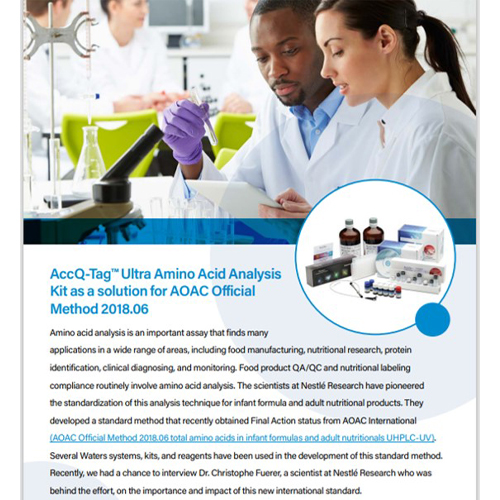
Download resource
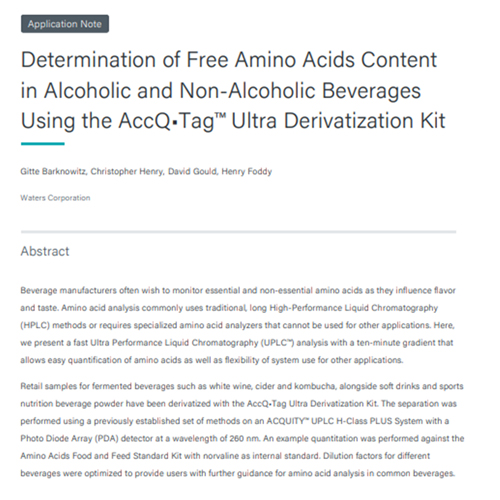
Download resource
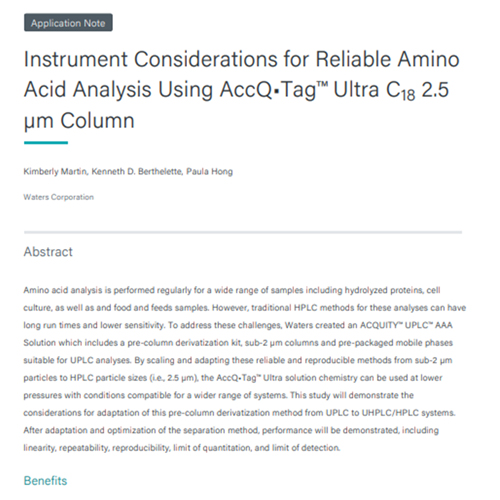
High-efficiency separations and quality data
Meet your regulatory requirements with confidence with the Arc HPLC System, designed to allow you to easily replicate and improve the performance of existing LC methods without compromising data quality.

A technology developed to help solve unpredictable chromatographic challenges
The MaxPeak Premier Solution, available in both Waters LC systems and columns, reduces variability associated with metal-sensitive analytes and minimizes variability of results.
A mass detector built around the needs of analytical scientists
Minimize the risk of unexpected coelutions or components and confirm trace components with the analytical confidence of the ACQUITY QDa Mass Detector.

A simplified solution for quantitating soft drink additives
The Waters Beverage Analysis Kit is a comprehensive, easy-to-use kit for rapid quantitation of six commonly used additives (acesulfame-K, saccharin, caffeine, benzoate, sorbate, and aspartame) in soft drink formulations.
Accurate amino acid composition analysis
The AccQ•Tag Ultra Columns are designed for reversed-phase separation of amino acids derivatized with AccQ•Tag Ultra reagent to deliver rapid separation of amino acids with superior resolution.
Elevate your chromatography with the universal language of the lab
The Empower Chromatography Data Software is designed to make it easier than ever to run samples and produce meaningful results without experiencing downtime for training, re-engineering workflow, or adding new software to support instruments or advanced chromatographic techniques.
*Certain images and/or photos on this page are the copyrighted property of 123RF.com,
its contributors or its licensed partners and are being used with permission under the relevant license. These
images and/or photos may not be copied or downloaded without permission from 123RF.com. Other images courtesy
of Waters®.